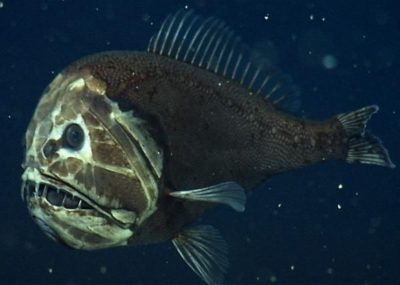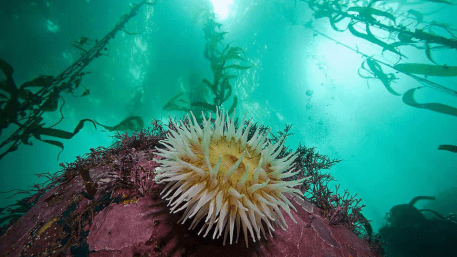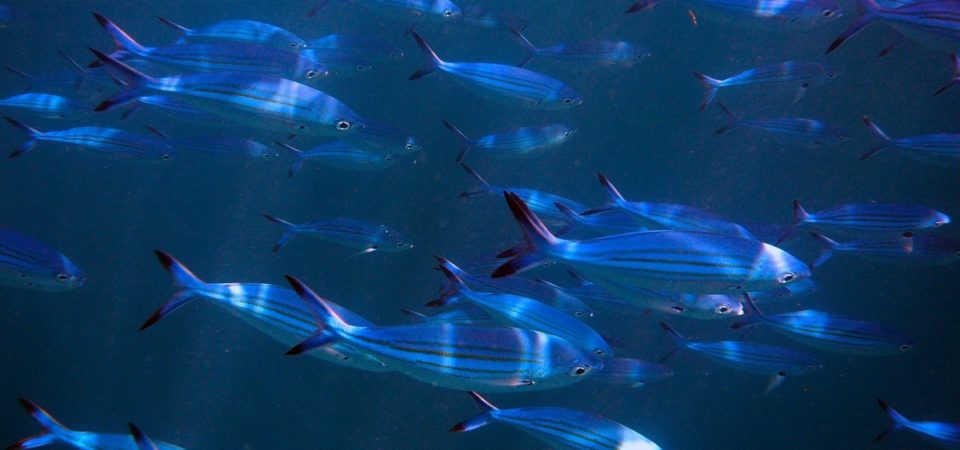Author(s): Gioietta Kuo
OUR DEEPEST OCEAN [1]
Our ocean is vast. The ocean surface is 300 times the size of our land dwelling area. It is extremely cold and covered in near-total darkness. Yet the blackness is alive, containing numerous unexplored mass of fantastic creatures!
The deep sea is roughly defined as what is below 200 meters. Very little sunlight penetrates beyond about 200 meters deep. Below about 1,000 meters, it is totally dark. Still, it consists of a huge one billion cubic kilometers of water and more than 90 percent of the living space on the planet.
If one dives beneath the ocean’s waves past the sunlit teeming waters near the surface, one would find the layers of water which is deficient in oxygen and seem to be totally devoid of life. Yet, one dives down further, more and more, down, down to a place where the pressure would crush a human, and you will find the mysterious, alien world of the deep ocean.
Despite the fact that this alien world is relatively accessible compared with even the planets in our own solar system, the deepest depth of the ocean is left virtually unexplored remaining as the final mysterious frontier of our home planet. The National Ocean Service provides data, tools, and services that support coastal economies and they make their contribution to the national economy [2].
MARIANNA TRENCH [3]
The deepest channel in our ocean is the Marianna trench [3]. Its deepest end is located in the western Pacific Ocean about 200 kilometers east of the Marianna islands. It is the deepest ocean trench on Earth at the junction of 2 tectonic plates – a fracture in the earth’s mantle. It is crescent-shaped and measures about 2,550 kilometers in length and 69 kilometers in width. The maximum known depth is 10,984 ± 25 meters.
In this system, the western edge of one plate, the Pacific Plate, is thrusted beneath the smaller Marianna Plate that lies to the west. Crustal material at the western edge of the Pacific Plate is some of the oldest oceanic crust on earth. It is up to 170 million years old and is, therefore, cooler and denser; hence its great height difference relative to the higher-riding (and younger) Mariana Plate that is the deepest point at the plate boundary.
SCIENTIFIC EXPLORATIONS
On average, the ocean’s average depth is 4,000 meters. This is the height of many peaks in the Rockies and the Alps.
Today scientists are still trying to answer the most fundamental questions about the deep ocean. In 2003, Vecchione of the Smithsonian Institution descended aboard a Russian submersible to the Charlie-Gibbs Fracture Zone, a fracture in the mid-Atlantic seafloor that is 4,500 meters at its deepest. Vecchione and other scientists who study the deep sea say one of their biggest challenges is trying to figure out what exactly lives down there. Although the Census of Marine Life [4], a decade-long international study, uncovered more than 1,200 new species – excluding microbes – in the planet’s oceans. The study also highlighted in particular just how much humans still have to learn about the deep ocean.
Edith Widder, CEO and senior scientist at the Ocean Research and Conservation Association said that there must be many animals, possibly large animals, down there that we don’t know about.
Over the last several decades, scientists have found some bizarre and massive creatures dwelling in the deep, such as the megamouth shark in figure 1.

This is a filter feeder that grows up to 5 meters long. Only dozens have ever been seen since they were discovered in the 1970s. Vecchione told OurAmazingPlanet:”When they were first discovered, it was a complete surprise nobody knew they even existed. Within the last 10 years, two large squid species have been found and there are other large things in the deep sea we have gotten glimpses of but have never caught, so we don’t know what we’re going to discover.”
Both Vecchione and Widder study the biology of the open waters of the deep ocean, known to researchers as the water column – a region even less explored than the ocean floor, and whose inhabitants are more difficult to find.
HARD TO CATCH
Both Vecchione and Widder say:”Stuff that’s on the bottom, some of it moves, but not very fast, and a lot of it is just stuck in one place. But in the water column, things move around. Those things can outrun a researcher’s trawling net.”
Until the relatively recent development of manned submersibles and remotely operated seafaring robots, nets were one of the few tools available to scientists trying to sample life from the darkness of the deep. And those nets missed more than just fast-moving animals like squid. They missed an entire class of creatures that appear to be one of the dominant life forms in the deep sea. Bruce Robison, a senior scientist at the Monterey Bay Aquarium Research Institute, says this is a finding that constitutes one of the biggest discoveries we’ve made in the last 10 years or so. It’s not until we started going down there that we realized that there is an astonishing number of gelatinous animals down there.
The deep ocean is a weird universe of jellyfish and their relations, forming sometimes chains many feet long, often lit by shimmering flickers of bioluminescence. It turns out they account for a whopping 25 percent of the biomass in the deep. Recent research
has revealed that the increases in jellyfish populations can be linked to human activity, too. As greenhouse gases trap heat on the planet, oceans are heating up – they absorb 93% of that excess heat. Unlike many marine species, jellies can thrive in warmer water with less oxygen [5].
“Maybe more,” Robison said. “But we didn’t know that, because if you drag a net through deep water, many of these gelatinous animals are shredded – they either turn into so much goo or pass through the net.”

Fanciful gelatinous organisms like this one are far more plentiful in the deep sea than previously suspected.
SAMPLES OF DEEP OCEAN CREATURES
Getty images has published many examples of deep sea creatures [6]. Most have no names. Some look like artists’ creations. You can see them here:
Figures 12 to figures 22. Are from National Geographic and may be seen here.
HOW MANY SPECIES LIVE IN THE OCEAN?[7]
Figure 23 Kelp forest below Monterey Bay California

Given the vast size of the ocean, it is impossible to know the exact number of species that live there. So the number is unknown. Research suggests, however, that the number of species in the ocean is decreasing. The continued decline in the health of many ecosystems, coupled with rising extinction rates, are likely outpacing species’ ability to evolve to tolerate the conditions of our rapidly changing planet. It is not all bad news though. Researchers around the world continue to study marine life and habitats to help develop new strategies to preserve vital ocean ecosystems.
Scientists estimate that 91 percent of ocean species have yet to be classified, and that more than 80 percent of our ocean is unmapped, unobserved and unexplored. While these statistics may sound daunting, they have not stopped the global scientific community from striving to amass as much knowledge as possible about ocean life.
One recent effort—The Census of marine Life [4]—was an international project spanning 10 years that recorded the diversity, distribution, and abundance of life in the ocean. More than 2,700 scientists from 80 nations contributed to the Census. The results of their research, which included 540 marine expeditions, were reported at The Royal Society of London in October 2010. The Ocean Biogeographic Information System contains the Census data. NOAA Fisheries is responsible for the protection, conservation, and recovery of endangered and threatened marine and estuarine species in the United States under the Endangered Species Act.
BIOLUMINESCENCE
Scientists say that in addition to figuring out what lives down there, they are also trying to figure out how things live down there, how nutrients move from the surface world down into a vast system that is cut off from the reach of the sun. They say they don’t know what the food web is like, they don’t know how that organic material transfers through the immense food web down to the deep sea floor. They know it goes from the beginning to the end, but as to how it gets there they are still in the dark, literally and figuratively.
In order to find food, find a mate, or stave off an attacker, many of the inhabitants make their own light to survive and communicate in the perpetual twilight or permanent night of the deep. Bioluminescence is a strange phenomenon. Scientists are only beginning to understand what they call “this language of light”. Given the sheer volume of the deep sea, a huge proportion of the animals on our planet are bioluminescent, and yet little is understood about the myriad ways organisms use self-made light. Travelers in the Suez Canal have observed bioluminescence on its surface.
CONNECTION OF CLIMATE CHANGE IN DEEP OCEAN TO OUR PREDICAMENT
Although it may lack the aesthetic thrill of deep ocean biology, – who can resist a fragile creature that can squirt light in the path of a lunging squid? Many scientists are also looking to the deep sea to try to solve some big questions about the role it plays in earth’s climate.
Gregory Johnson, an oceanographer with the National Oceanic and Atmospheric Administration’s Pacific Marine Environmental Laboratory said: “The oceans are taking up a huge amount of the heat resulting from global warming. We have a pretty good handle on how much the upper ocean is warming, but not as good a handle on how much the deep ocean is warming.”
Figuring out how temperature changes move through the deep ocean has implications for our civilization in our present predicament. This is vital for ocean dwellers and land dwellers alike since the vast oceans take up the vast majority of the heat. Earth is warming in the future due to changes in greenhouse gas concentrations and other changes, therefore we need to know how much energy the oceans are taking up now. That’s a very important constraint for weather predictions and how it relates to our predicament. Scientists depend on ships and, to some extent, a growing but still comparatively tiny network of ocean buoys to take measurements of conditions in the deep ocean – everything from temperature to salinity (salt content) and water chemistry.
GRAND DISCOVERING AHEAD FOR OUR PLANET?
Because so little is known about the deep ocean and the mechanisms that govern it, the possibilities are ripe for grand discoveries. One overarching question confronting deep sea scientists across many disciplines concerns the ingredients and mechanics of our planet as a whole: How does what we do up here affect the deep oceans, and how do the deep oceans affect things up here?
“In many very real ways, the deep ocean is like the flywheel on the engine of the planet. It dominates organic carbon flux on earth. And the magnitude of it is so great that I think we fail to appreciate it,” said MBARI’s Robison. “But if we start tampering with it, and clearly we are, then we could see some very big changes in the part of the planet where we live.”
Cindy Lee Van Dover, a marine scientist and professor at Duke University, said that the way carbon is cycled by the animals that live in deep oceans is of great importance. It
affects the chemistry of the deep, which affects the oceans in general, which affects the atmosphere on earth and vice versa.
“The deep sea, the ocean, the atmosphere we’re still trying to figure out how all those are connected,” Van Dover said. Scientists at this point are still just trying to figure out what is there, she added.
FINAL FRONTIER OF OUR PLANET? DEEP OCEAN A CHALLENGE TO OUR PREDICAMENT
More humans, 12 in all, have walked on the moon than have traveled to the deepest parts of our own planet. Underwater technology has come a long way since the 1960s. In 1964 The Alvin took its free dive to 10.7 meters below the surface. Today, scientists have access to a wide range of technologies that routinely carry them down to 4500 meters. These human occupied vehicles (HOV) have robotic arms enabling them to scoop up marine creatures and sediments.
Only two have the distinction of visiting the very deepest spot – the ‘Challenger Deep’ in the Marianna trench, which lies 11,030 meters beneath the surface of the western Pacific Ocean. National Geographic explorer James Cameron became the first human to complete a solo submarine dive to the ’Challenger Deep’ in 2012. He collected much important scientific information – data, specimens and images. Previous to that in 1960, U.S. Navy Lt. Don Walsh and Jacques Piccard, a renowned Swiss explorer, rode a massive metal vessel to the seafloor and spent 20 minutes in the darkness there.
Despite the fact we know little of the deep ocean, studying the ocean in various aspects – geography, marine inhabitants, fauna, ecosystems all have an extremely essential intrinsic value and present challenges to the human predicament. So far only 1% of the deep ocean floor has been explored. Under the waves are trenches, canyons, plains, sea mounts, continental margins, tectonic plates, hydrothermal vents, volcanoes, methane seeps, and mid-ocean ridges that run like mountain ranges through the ocean. We need to have meticulous knowledge of every feature before humans can make good use of the ocean. As the world expands in every direction, this study has become more and more necessary and urgent.
Following are aspects impacting our society’s connection to the deep ocean: * Indispensable Cables On Ocean Floor – Our Internet
As the world’s economy expands, global communication is becoming very important. Reaching out to the boundaries of our environment our civilization is intimately connected to the deep ocean. It is not sufficiently recognized that our entire data communication system – the Internet we so depend on daily is carried by the submarine communication cables across our vast oceans. 99 percent of international data communication is carried on the ocean floor. Who would have imagined that today the seabed is dotted with cables which are so vital to the world’s economy?
Laying cables on the ocean floor across the vast distances is a fascinating business. The submarine cable consisting of bundles of power lines and fiber optic lines are carried on board ship and slowly laid on the ocean floor. They carry terabytes of data for less than a billion per communications lines using laser technology [8].
In total, they are hundreds of kilometers long and can be as deep as Everest is tall. The cables are installed by special boats called cable-layers. It’s more than a matter of dropping wires with anvils attached to them – the cables must generally be run across flat surfaces of the ocean floor, and care is taken to avoid coral reefs, sunken ships, fish beds, and other ecological habitats and general obstructions. The diameter of a shallow water cable is about the same as a soda can, while deep water cables are much thinner —about the size of a Magic Marker.
If there is an earthquake or chewed by sharks, repairing these breakages with divers or robot operated vehicles can pose a daunting problem.
* Scientific Value
Most expeditions result in new species being found, sometimes entire new ecosystems are discovered. An understanding of the biochemistry of these marine creatures can lead to medical, genetic, pharmaceutical and other advances. Their locomotion under high pressure may be used for robot design.
The specialized adaptations of the marine creatures living in the deep enable us to understanding their biochemistry. For example, where the food they eat come from? It turns out there are microbes by the volcanic hydrothermal vents. They produce food which are then ingested by the marine creatures [9].
* Fisheries
Commercial fisheries are increasingly being exploited for food, both in national waters and on the high seas [10]. For example, Patagonian tooth fish lives below 2500 meters. [11]
Figure 24. Patagonian tooth fish
Its tasty flesh can fetch $35/kg. With overfishing having depleted many epipelagic and coastal fisheries, as many as 40% of the world’s fishing grounds are now in waters deeper than 200 meters. With global overpopulation, there is more and more pressure to look for new avenues of food to feed the ever growing number of mouths to feed in our world.
* Ubiquitous Plastic Pollution
With the billion tons of plastic waste we dump into the ocean, where does it go? First it disintegrates into small micro plastic elements. It is sad that plastic waste has reached the deepest levels of the world’s oceans. Because there is nowhere to go, the deep ocean has eventually become the “ Ultimate Sink” for plastic waste [12].
Scientists have discovered organisms that had ingested micro plastics at the bottom of the Marianna trench. The effects of this are yet unclear, though scientists speculate they will experience the same problems of blocked digestive tracts and restricted mobility as creatures at lower depths like the whales on the surface. They may also be more vulnerable because the trenches are food-scarce ecosystems, which prompts scavengers and predators to gobble up anything they can find. Eventually this does not bode well for humans because we end up eating these marine creatures.
* The Role of Deep Ocean Climate Change – a Threat To Our Civilization.
The ocean contains a vast amount of water and it therefore absorbs a phenomenal amount of heat and carbon dioxide. It serves to moderate the surface climate. it is also a critical buffer in exposing vulnerable ecosystems for combined stresses of warming, ocean acidification, deoxygenation and altered food inputs. Biodiversity may be threatened and all this can influence a healthy planet for human lives. A study published in NATURE finds that different levels of the ocean would change at different rates but that by the second half of the century there will be a rapid acceleration of climate change exposure throughout out the water – 7 times higher than current levels [13].
* Extra-terrestial Space Travel
An alien world of life has emerged as humans have explored the pitch-black depths with ever-improving technologies. These fantastic discoveries are dramatically widening our perspective of the oceans, and rewriting our understanding of the limits of life on land as we know it in our present society which is being threatened and stressed from all directions. These deep ocean marine life are shaping our sense of what’s possible, and luring us to think beyond basic assumptions – both in terms of exploring Earth and the vast reaches of space in our planet.
In the search for extra-terrestrial life, scientists are turning to our own deep oceans for inspiration and understanding of ourselves. NASA has begun to help fund some deep sea explorations, and some astro-biologists have teamed up with marine biologists and
oceanographers to probe the boundaries of biology here on earth and in the depth of our deep oceans. Exploring the unfamiliar environments in the deep sea reveals invaluable lessons for exploring outer space. But it also emboldens scientists to stretch their thinking and open their minds to the impossible.
Conclusion
It is clear from just the fascinating images illustrated here that the vast deep oceans harbor a world we have not yet explored. Many of the weird creatures have not even been named let alone their symbiosis and interactions with the environment. Scientists are eager to go there for a variety of reasons apart from the simple scientific curiosity that beckons us. The vast oceans take up most of the earth’s warming and we need to know the role the deep ocean plays in the very important climate change we are studying on the surface. The sheer number of unclassified creatures in the deep oceans is enormous and our planet will do well to increase our exploration of this vast resource which we have not sufficiently observed and mapped.
We have listed the challenges to our predicaments in the ever expanding world confronting us today. More and more we turn to the unexplored and unexploited deep oceans for understanding and use as models for possible solutions. Let us just hope that good sense will lead us to reaping the fruits of exploration without destroying the pristine nature of this vast reserve of resources!
Gioietta Kuo
JAN 2021
REFERENCES
[1] Earth’s Final Frontier: Mysteries of the Deep Seas
www.livescience.com › 30890-ocean-deep-mysteries-e…
Andrea Mustain OurAmazingPlanet staff writer Andrea Mustain on
Twitter:@andreamustain. Follow OurAmazingPlanet for the latest in Earth science and exploration news on Twitter @OAPlanet and on Facebook.
[2] National Ocean and Atmospheric Administration. . NOAA. US Dept of Commerce www.usa.gov>federal agencies>national oceanic and atmospheric administration [3] Marianna trench. WIKIPEDIA
en.wikipedia.org>wiki>marianna_trench
[4] Census of marine Life
www.coml.org Oceanservice.NOAA. gov>facts>marine census-
[5]. Which creatures will thrive in warmer oceans
www.businessinsider>science>tech insider
[6] Getty Images. Pxhere.com and pixabay.com
[7]. How many species live in the ocean
www.oceanservice.noaa.gov>facts>ocean-species
[8] 10 facts about the Internet’s undersea cableslmental Floss
www.mentalfloss.com>article>10-facts-about-internet
[9] Deep sea Hydrothermal vents www.nationalgeographic.org> media> deep sea hydro….
[10] Deep sea fishing World ocean review Worldoceanreview.com> for-2 > fisheries > deep-sea-f…
[11] Patagonian tooth fish – Oceana
Oceana.org > marine-life- > ocean_ fishes > Patagonian- toot…
[12] Oceans dubbed ;ultimate sink; for plastic waster – Inhabitat Inhabitat.com >. News [13] Climate change in deep oceans could be seven times faster… www.theguardian.com > environment > may > climate-ch…
www.oceanservice.noaa.gov>facts>ocean-species
The views and opinions expressed through the MAHB Website are those of the contributing authors and do not necessarily reflect an official position of the MAHB. The MAHB aims to share a range of perspectives and welcomes the discussions that they prompt.
